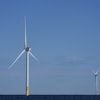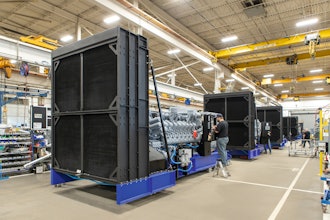Tucked away in a corner on the first floor of the Jacob Javits Center, a test track had been set up — because it could be. With no emissions and barely any sound, the all-electric vehicles on the Clean Air Test Track were uniquely suited for ride-alongs. When I attended the show last Thursday I was able to take a ride in three of the cars listed here — the Nissan Leaf, BMW i3, and the all-electric Honda Fit. With battery technology enabling these cars to run longer using smaller motors, these companies are working on increasing the number of electric cars on the road. “Range anxiety” is still a real danger, with few cars approaching the Chevrolet Bolt’s advertised 200 miles, but this year’s auto show was a testament to how seriously automakers are taking the electric revolution — if you know where to look.
Chevrolet Bolt
Chevy’s plug-in crossover is built around a nickel-rich lithium-ion battery with an energy capacity of 60 kWh, which provides that more than 200 miles of range mentioned earlier. It’s estimated to fully charge in about 9 hours on a professionally installed 240-volt charger. The Bolt will cost you about $30,000 after federal tax credit with a $37,500 MSRP, a higher starting price than the hybrid Volt. The interior boasts a trendy touch-screen interface — the 10.2-inch center console and 8-inch instrument cluster are both customizable, and the center console can also be used with gesture controls.
Nissan Leaf
Nissan’s goal of aligning its electric vehicles with environmental sustainability is right there in the name, and the 2016 Leaf is the product of almost 20 years of development in the emissions-free space. The 2016 Leaf has a 107 mile maximum range and a 24-30 kWh Lithium-ion battery, accounting for the different battery sizes depending on the model. The highest-end version retails for $36,790 starting MSRP and boasts 187 lb-ft of torque and 107 hp. Regenerative breaking is included to draw energy when the car is coasting or breaking, and the optional “B-Mode” increases break response and regenerative braking force. The B-Mode is one of the more unique components we spotted on the Leaf.
BMW i3
BMW had two alternative fuel vehicles at the show; the all-electric i3, which was available at the test track, and the sleek i8, a plug-in hybrid. The i3’s impressive acceleration makes hauling its comfortable four-passenger body feel easy. In order to reduce weight, BMW made the framework of the car out of carbon fiber reinforced plastic, which is half the weight of steel. They’ve also built their electric cars on two modular units, a Life Module for the upper frame and a Drive Module for the drivetrain and under-body. The i3 starts at a MSRP of $42,400 and gets up to 81 miles per charge or 150 miles with the optional range extender.
Kia Soul
The Soul isn’t quite as sleek as some of the other electric cars that were on display at NYIAS, but the all-electric crossover SUV does have a decent pure electric range of 93 miles. It’s essentially the same as the traditional Kia Soul except for the DC Fast Charge port installed at the front of the vehicle for fast charging on the standard port. The Soul EV runs on a 27 kWh Lithium Ion Polymer battery and 109hp AC synchronous electric motor and features 210 lb-ft of torque. The interior console includes a built-in, illuminated USB/auxiliary port, energy usage monitoring, and a driver-only HV/AC function that enables heating and cooling of just the driver’s side.
Honda Fit
Honda’s sturdy Fit EV hatchback has been around since 2015, although the history of Honda electric vehicles in general stretches back to the EV Plus in 1997. Its range is a serviceable 82 miles, generated by a lithium-ion battery. The 92 kWh coaxial electric motor is the same one used on the FCX Clarity fuel cell vehicle, and produces more torque than the Fit with a combustion engine, 106 lb-ft to 189 lb-ft. Two modes, SPORT or ECON, offer more power or more energy savings respectively.
The honorable mention on this list goes to the Hyundai Ioniq, which comes in hybrid, electric, and plug-in hybrid versions all built on the same platform. Editor Lee Goldberg detailed the Ioniq in his list of eco-friendly cars.






















